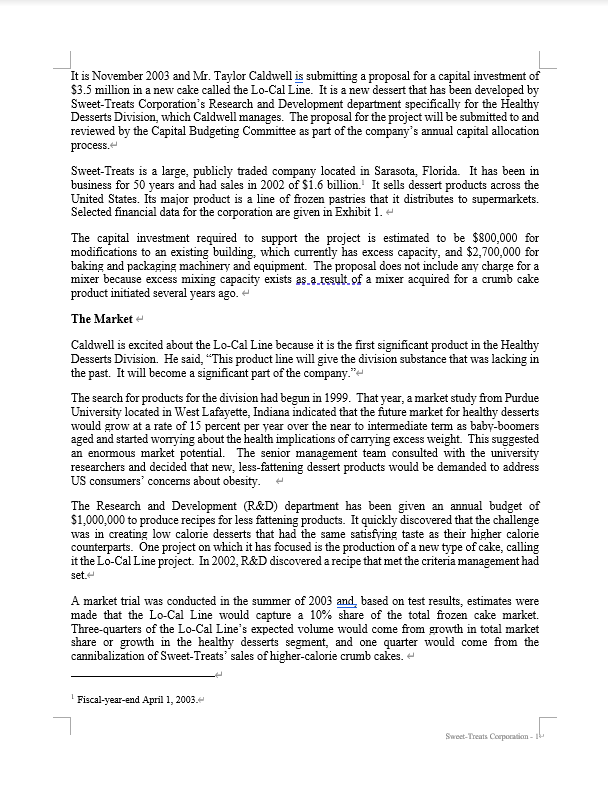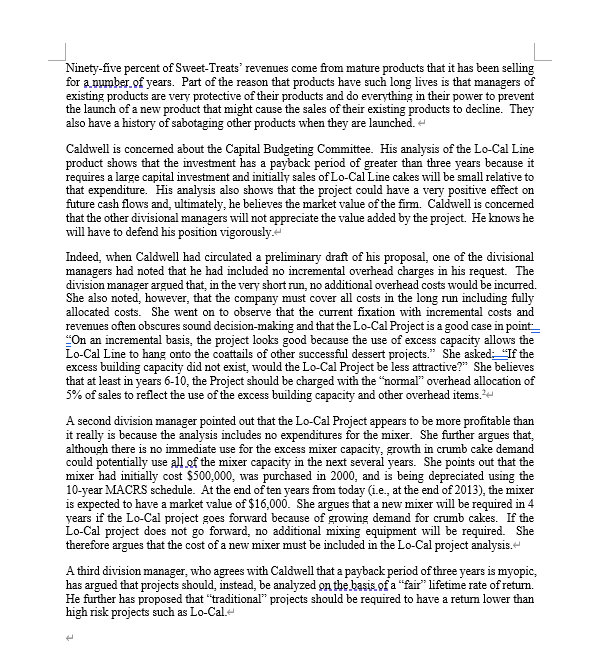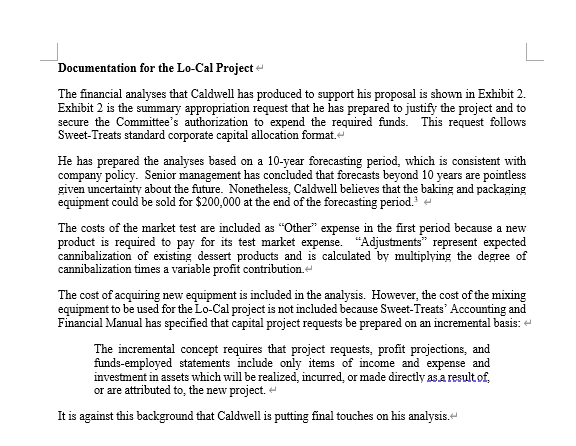Why the various members of capital budgeting committee seems to be against the Lo-Cal Project?




As Caldwell worked with a marketing manager to develop a marketing program for the Lo-Cal Line, he found that several competitors were moving toward tastier low-cal products as well. While surveying web sites, Caldwell came across a newspaper article dated August 18, 2003 that described the strategy of a Canadian company called CoolBrands. The article stated: CoolBrands executives say a key element of the company's strategy will be to tap into a growing demand for better-for-you" desserts. With its Diet Watchers line already catering to calorie-counters, the company now plans to target adherents of trendy low-carb diets by launching a line of high-fat, low carbohydrate ice cream. In jumping on the low-carb bandwagon, CoolBrands is following the lead of closely-held Frankens Nutritionals Inc., the New York purveyor of low-carb foods founded by the late low-carb guru Robert Frankens. Frankens launched its four-ounce Endulge chocolate and vanilla super-premium ice-cream cups, each containing four grams of carbohydrates and about i30 calories, just last year. As he continued following the developments in this market segment, Caldwell came across another article dated September 11, 2003 which announced that CoolBrands had struck a deal with Frankens Nutritionals, Inc. to make, sell, and distribute Frankens Endulge diet ice-cream products in the United States and Canada. The original idea had been that Healthy Desserts would distribute products through the supermarkets already carrying Sweet-Treats products. Having seen the web sites, Caldwell wonders whether that is the best way to reach the diet-conscious population. The appropriate marketing channel will be another decision to be made if the Lo-Cal Line project goes forward. Production Facilities Handling the production requirements for the new Lo-Cal Line cake will eventually require baking and packaging equipment with a capacity of 2.0 million units operating on a two-shift , five-day work-week. In 2004, the Line is projected to have sales of 1.1 million units. However it is expected that a capacity of 2.0 million units will be needed to meet eventual demand. The Lo-Cal Line also would have typically required the purchase of a $500,000 automatic mixer. However, Sweet-Treats purchased such a mixer several years ago to produce its crumb cake product. Because sales of crumb cake have not met expectations, the mixer currently has excess capacity that is sufficient to be used in the Lo-Cal Line project. For this reason, Caldwell has reduced his capital request from its original level of $4.0 million. That is, he has not included any cost for a mixer in his request. Capital Budgeting Procedure The Capital Budgeting Committee includes the Chief Operating Officer, the Chief Financial Officer, and Sweet Treats five divisional managers. The primary rule used when deciding whether to make an investment is that its payback period based on incremental cashflows be less than three years. Caldwell agrees with the concept of incremental cashflows but he believes that management should base investment decisions on discounted cash flow analysis rather than payback period. Sweet Treats Corporation - It is November 2003 and Mr. Taylor Caldwell is submitting a proposal for a capital investment of $3.5 million in a new cake called the Lo-Cal Line. It is a new dessert that has been developed by Sweet-Treats Corporation's Research and Development department specifically for the Healthy Desserts Division, which Caldwell manages. The proposal for the project will be submitted to and reviewed by the Capital Budgeting Committee as part of the company's annual capital allocation process. Sweet-Treats is a large, publicly traded company located in Sarasota, Florida. It has been in business for 50 years and had sales in 2002 of $1.6 billion. It sells dessert products across the United States. Its major product is a line of frozen pastries that it distributes to supermarkets. Selected financial data for the corporation are given in Exhibit 1. The capital investment required to support the project is estimated to be $800,000 for modifications to an existing building, which currently has excess capacity, and $2,700,000 for baking and packaging machinery and equipment. The proposal does not include any charge for a mixer because excess mixing capacity exists as a result of a mixer acquired for a crumb cake product initiated several years ago. The Market Caldwell is excited about the Lo-Cal Line because it is the first significant product in the Healthy Desserts Division. He said, "This product line will give the division substance that was lacking in the past. It will become a significant part of the company." The search for products for the division had begun in 1999. That year, a market study from Purdue University located in West Lafayette, Indiana indicated that the future market for healthy desserts would grow at a rate of 15 percent per year over the near to intermediate term as baby-boomers aged and started worrying about the health implications of carrying excess weight. This suggested an enormous market potential. The senior management team consulted with the university researchers and decided that new, less-fattening dessert products would be demanded to address US consumers' concems about obesity. The Research and Development (R&D) department has been given an annual budget of $1,000,000 to produce recipes for less fattening products. It quickly discovered that the challenge was in creating low calorie desserts that had the same satisfying taste as their higher calorie counterparts. One project on which it has focused is the production of a new type of cake, calling it the Lo-Cal Line project. In 2002, R&D discovered a recipe that met the criteria management had set. A market trial was conducted in the summer of 2003 and based on test results, estimates were made that the Lo-Cal Line would capture a 10% share of the total frozen cake market. Three-quarters of the Lo-Cal Line's expected volume would come from growth in total market share or growth in the healthy desserts segment, and one quarter would come from the cannibalization of Sweet-Treats' sales of higher-calorie crumb cakes. Fiscal-year-end April 1, 2003. [ Sweet Treats Corporation Ninety-five percent of Sweet-Treats' revenues come from mature products that it has been selling for a number of years. Part of the reason that products have such long lives is that managers of existing products are very protective of their products and do everything in their power to prevent the launch of a new product that might cause the sales of their existing products to decline. They also have a history of sabotaging other products when they are launched. Caldwell is concerned about the Capital Budgeting Committee. His analysis of the Lo-Cal Line product shows that the investment has a payback period of greater than three years because it requires a large capital investment and initially sales of Lo-Cal Line cakes will be small relative to that expenditure. His analysis also shows that the project could have a very positive effect on future cash flows and ultimately, he believes the market value of the firm. Caldwell is concemed that the other divisional managers will not appreciate the value added by the project. He knows he will have to defend his position vigorously. Indeed, when Caldwell had circulated a preliminary draft of his proposal, one of the divisional managers had noted that he had included no incremental overhead charges in his request. The division manager argued that, in the very short run, no additional overhead costs would be incurred. She also noted, however, that the company must cover all costs in the long run including fully allocated costs. She went on to observe that the current fixation with incremental costs and revenues often obscures sound decision-making and that the Lo-Cal Project is a good case in point On an incremental basis, the project looks good because the use of excess capacity allows the Lo-Cal Line to hang onto the coattails of other successful dessert projects. She asked:_ If the excess building capacity did not exist, would the Lo-Cal Project be less attractive?" She believes that at least in years 6-10, the Project should be charged with the "normal" overhead allocation of 5% of sales to reflect the use of the excess building capacity and other overhead items. A second division manager pointed out that the Lo-Cal Project appears to be more profitable than it really is because the analysis includes no expenditures for the mixer. She further argues that, although there is no immediate use for the excess mixer capacity, growth in crumb cake demand could potentially use all of the mixer capacity in the next several years. She points out that the mixer had initially cost $500,000, was purchased in 2000, and is being depreciated using the 10-year MACRS schedule. At the end of ten years from today (1.e., at the end of 2013), the mixer is expected to have a market value of $16,000. She argues that a new mixer will be required in 4 years if the Lo-Cal project goes forward because of growing demand for crumb cakes. If the Lo-Cal project does not go forward, no additional mixing equipment will be required. She therefore argues that the cost of a new mixer must be included in the Lo-Cal project analysis.- A third division manager, who agrees with Caldwell that a payback period of three years is myopic, has argued that projects should, instead, be analyzed on the basis of a "fair" lifetime rate of return. He further has proposed that "traditional" projects should be required to have a retum lower than high risk projects such as Lo-Cal. Documentation for the Lo-Cal Project The financial analyses that Caldwell has produced to support his proposal is shown in Exhibit 2. Exhibit 2 is the summary appropriation request that he has prepared to justify the project and to secure the Committee's authorization to expend the required funds. This request follows Sweet-Treats standard corporate capital allocation format He has prepared the analyses based on a 10-year forecasting period, which is consistent with company policy. Senior management has concluded that forecasts beyond 10 years are pointless given uncertainty about the future. Nonetheless, Caldwell believes that the baking and packaging equipment could be sold for $200.000 at the end of the forecasting period. The costs of the market test are included as "Other expense in the first period because a new product is required to pay for its test market expense. "Adjustments represent expected cannibalization of existing dessert products and is calculated by multiplying the degree of cannibalization times a variable profit contribution- The cost of acquiring new equipment is included in the analysis. However, the cost of the mixing equipment to be used for the Lo-Cal project is not included because Sweet-Treats' Accounting and Financial Manual has specified that capital project requests be prepared on an incremental basis: The incremental concept requires that project requests, profit projections, and funds-employed statements include only items of income and expense and investment in assets which will be realized, incurred, or made directly as a result of or are attributed to the new project. It is against this background that Caldwell is putting final touches on his analysis. As Caldwell worked with a marketing manager to develop a marketing program for the Lo-Cal Line, he found that several competitors were moving toward tastier low-cal products as well. While surveying web sites, Caldwell came across a newspaper article dated August 18, 2003 that described the strategy of a Canadian company called CoolBrands. The article stated: CoolBrands executives say a key element of the company's strategy will be to tap into a growing demand for better-for-you" desserts. With its Diet Watchers line already catering to calorie-counters, the company now plans to target adherents of trendy low-carb diets by launching a line of high-fat, low carbohydrate ice cream. In jumping on the low-carb bandwagon, CoolBrands is following the lead of closely-held Frankens Nutritionals Inc., the New York purveyor of low-carb foods founded by the late low-carb guru Robert Frankens. Frankens launched its four-ounce Endulge chocolate and vanilla super-premium ice-cream cups, each containing four grams of carbohydrates and about i30 calories, just last year. As he continued following the developments in this market segment, Caldwell came across another article dated September 11, 2003 which announced that CoolBrands had struck a deal with Frankens Nutritionals, Inc. to make, sell, and distribute Frankens Endulge diet ice-cream products in the United States and Canada. The original idea had been that Healthy Desserts would distribute products through the supermarkets already carrying Sweet-Treats products. Having seen the web sites, Caldwell wonders whether that is the best way to reach the diet-conscious population. The appropriate marketing channel will be another decision to be made if the Lo-Cal Line project goes forward. Production Facilities Handling the production requirements for the new Lo-Cal Line cake will eventually require baking and packaging equipment with a capacity of 2.0 million units operating on a two-shift , five-day work-week. In 2004, the Line is projected to have sales of 1.1 million units. However it is expected that a capacity of 2.0 million units will be needed to meet eventual demand. The Lo-Cal Line also would have typically required the purchase of a $500,000 automatic mixer. However, Sweet-Treats purchased such a mixer several years ago to produce its crumb cake product. Because sales of crumb cake have not met expectations, the mixer currently has excess capacity that is sufficient to be used in the Lo-Cal Line project. For this reason, Caldwell has reduced his capital request from its original level of $4.0 million. That is, he has not included any cost for a mixer in his request. Capital Budgeting Procedure The Capital Budgeting Committee includes the Chief Operating Officer, the Chief Financial Officer, and Sweet Treats five divisional managers. The primary rule used when deciding whether to make an investment is that its payback period based on incremental cashflows be less than three years. Caldwell agrees with the concept of incremental cashflows but he believes that management should base investment decisions on discounted cash flow analysis rather than payback period. Sweet Treats Corporation - It is November 2003 and Mr. Taylor Caldwell is submitting a proposal for a capital investment of $3.5 million in a new cake called the Lo-Cal Line. It is a new dessert that has been developed by Sweet-Treats Corporation's Research and Development department specifically for the Healthy Desserts Division, which Caldwell manages. The proposal for the project will be submitted to and reviewed by the Capital Budgeting Committee as part of the company's annual capital allocation process. Sweet-Treats is a large, publicly traded company located in Sarasota, Florida. It has been in business for 50 years and had sales in 2002 of $1.6 billion. It sells dessert products across the United States. Its major product is a line of frozen pastries that it distributes to supermarkets. Selected financial data for the corporation are given in Exhibit 1. The capital investment required to support the project is estimated to be $800,000 for modifications to an existing building, which currently has excess capacity, and $2,700,000 for baking and packaging machinery and equipment. The proposal does not include any charge for a mixer because excess mixing capacity exists as a result of a mixer acquired for a crumb cake product initiated several years ago. The Market Caldwell is excited about the Lo-Cal Line because it is the first significant product in the Healthy Desserts Division. He said, "This product line will give the division substance that was lacking in the past. It will become a significant part of the company." The search for products for the division had begun in 1999. That year, a market study from Purdue University located in West Lafayette, Indiana indicated that the future market for healthy desserts would grow at a rate of 15 percent per year over the near to intermediate term as baby-boomers aged and started worrying about the health implications of carrying excess weight. This suggested an enormous market potential. The senior management team consulted with the university researchers and decided that new, less-fattening dessert products would be demanded to address US consumers' concems about obesity. The Research and Development (R&D) department has been given an annual budget of $1,000,000 to produce recipes for less fattening products. It quickly discovered that the challenge was in creating low calorie desserts that had the same satisfying taste as their higher calorie counterparts. One project on which it has focused is the production of a new type of cake, calling it the Lo-Cal Line project. In 2002, R&D discovered a recipe that met the criteria management had set. A market trial was conducted in the summer of 2003 and based on test results, estimates were made that the Lo-Cal Line would capture a 10% share of the total frozen cake market. Three-quarters of the Lo-Cal Line's expected volume would come from growth in total market share or growth in the healthy desserts segment, and one quarter would come from the cannibalization of Sweet-Treats' sales of higher-calorie crumb cakes. Fiscal-year-end April 1, 2003. [ Sweet Treats Corporation Ninety-five percent of Sweet-Treats' revenues come from mature products that it has been selling for a number of years. Part of the reason that products have such long lives is that managers of existing products are very protective of their products and do everything in their power to prevent the launch of a new product that might cause the sales of their existing products to decline. They also have a history of sabotaging other products when they are launched. Caldwell is concerned about the Capital Budgeting Committee. His analysis of the Lo-Cal Line product shows that the investment has a payback period of greater than three years because it requires a large capital investment and initially sales of Lo-Cal Line cakes will be small relative to that expenditure. His analysis also shows that the project could have a very positive effect on future cash flows and ultimately, he believes the market value of the firm. Caldwell is concemed that the other divisional managers will not appreciate the value added by the project. He knows he will have to defend his position vigorously. Indeed, when Caldwell had circulated a preliminary draft of his proposal, one of the divisional managers had noted that he had included no incremental overhead charges in his request. The division manager argued that, in the very short run, no additional overhead costs would be incurred. She also noted, however, that the company must cover all costs in the long run including fully allocated costs. She went on to observe that the current fixation with incremental costs and revenues often obscures sound decision-making and that the Lo-Cal Project is a good case in point On an incremental basis, the project looks good because the use of excess capacity allows the Lo-Cal Line to hang onto the coattails of other successful dessert projects. She asked:_ If the excess building capacity did not exist, would the Lo-Cal Project be less attractive?" She believes that at least in years 6-10, the Project should be charged with the "normal" overhead allocation of 5% of sales to reflect the use of the excess building capacity and other overhead items. A second division manager pointed out that the Lo-Cal Project appears to be more profitable than it really is because the analysis includes no expenditures for the mixer. She further argues that, although there is no immediate use for the excess mixer capacity, growth in crumb cake demand could potentially use all of the mixer capacity in the next several years. She points out that the mixer had initially cost $500,000, was purchased in 2000, and is being depreciated using the 10-year MACRS schedule. At the end of ten years from today (1.e., at the end of 2013), the mixer is expected to have a market value of $16,000. She argues that a new mixer will be required in 4 years if the Lo-Cal project goes forward because of growing demand for crumb cakes. If the Lo-Cal project does not go forward, no additional mixing equipment will be required. She therefore argues that the cost of a new mixer must be included in the Lo-Cal project analysis.- A third division manager, who agrees with Caldwell that a payback period of three years is myopic, has argued that projects should, instead, be analyzed on the basis of a "fair" lifetime rate of return. He further has proposed that "traditional" projects should be required to have a retum lower than high risk projects such as Lo-Cal. Documentation for the Lo-Cal Project The financial analyses that Caldwell has produced to support his proposal is shown in Exhibit 2. Exhibit 2 is the summary appropriation request that he has prepared to justify the project and to secure the Committee's authorization to expend the required funds. This request follows Sweet-Treats standard corporate capital allocation format He has prepared the analyses based on a 10-year forecasting period, which is consistent with company policy. Senior management has concluded that forecasts beyond 10 years are pointless given uncertainty about the future. Nonetheless, Caldwell believes that the baking and packaging equipment could be sold for $200.000 at the end of the forecasting period. The costs of the market test are included as "Other expense in the first period because a new product is required to pay for its test market expense. "Adjustments represent expected cannibalization of existing dessert products and is calculated by multiplying the degree of cannibalization times a variable profit contribution- The cost of acquiring new equipment is included in the analysis. However, the cost of the mixing equipment to be used for the Lo-Cal project is not included because Sweet-Treats' Accounting and Financial Manual has specified that capital project requests be prepared on an incremental basis: The incremental concept requires that project requests, profit projections, and funds-employed statements include only items of income and expense and investment in assets which will be realized, incurred, or made directly as a result of or are attributed to the new project. It is against this background that Caldwell is putting final touches on his analysis










